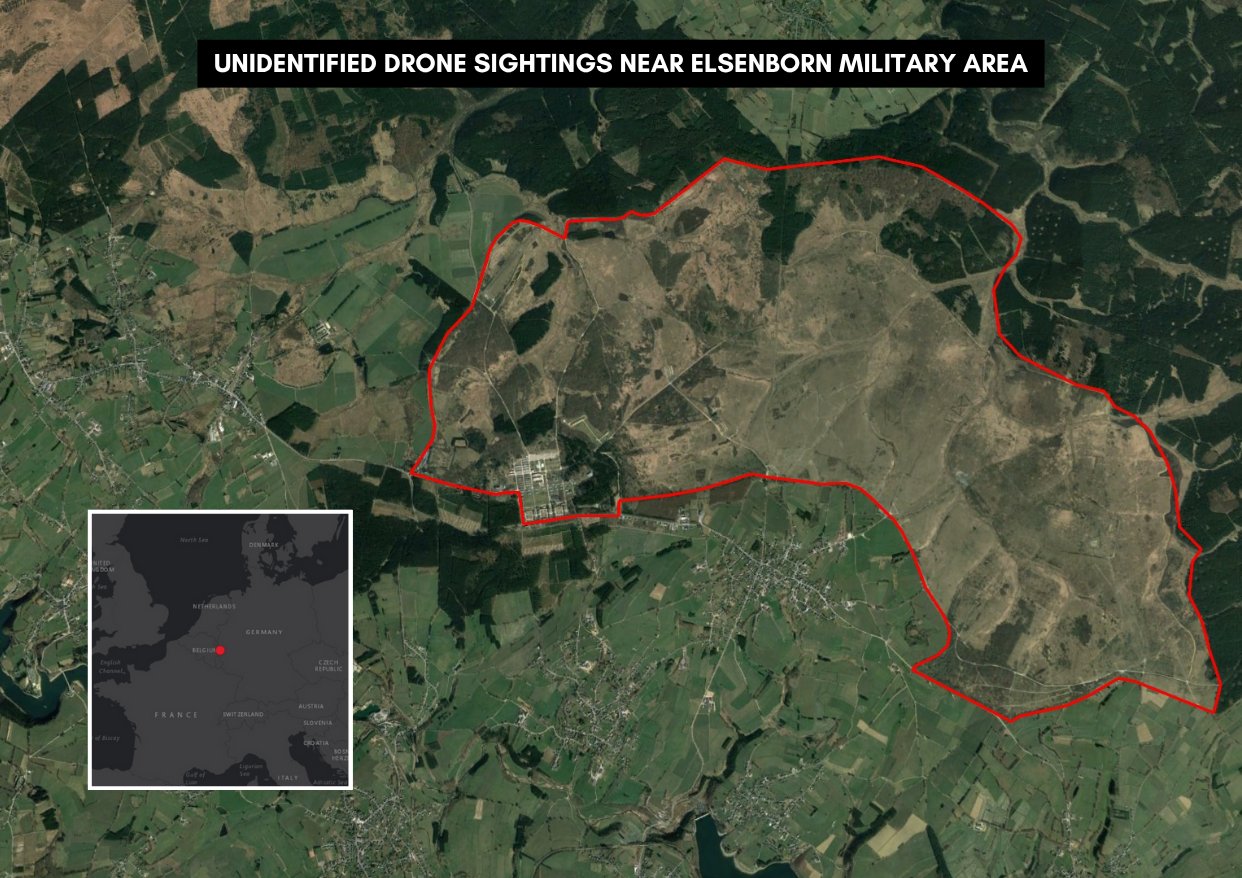15 Unidentified Drones Breach Belgian Military Airspace, Cross Into Germany — NATO on Alert Amid Growing Drone Incursions
An alarming breach of NATO airspace has reportedly unfolded as 15 unidentified drones were spotted flying over Belgium’s Elsenborn military base before crossing into German territory, according to Belgian broadcaster VRT NWS.
The drones—whose origin and operators remain unknown—were detected around 1:45 a.m. local time, and the incident has triggered urgent investigations by Belgian and German defense agencies.
 |
| Drones were spotted flying over Elsenborn military area in Belgium. via: OSINT Global |
Dual Incidents in Belgian and German Airspace
According to VRT NWS, a Belgian test aircraft operating in the area confirmed the presence of the drones, which flew at multiple altitudes over both Belgian and German sides of the border. Local police in Düren, western Germany, also reported visual contact with the drone swarm as they entered German airspace.
Defense expert Jens Franssen, speaking to VRT, suggested that the Elsenborn base—while not strategically significant—could have been a diversion. The Kleine-Brogel airbase, just 50 km away and known to store U.S. nuclear weapons, may have been the real target.
“This is a bizarre incident, and it's likely a form of hybrid warfare designed to provoke or test our systems,” Franssen noted, underlining the urgent need for Europe to improve its capacity to detect, trace, and neutralize small, unmanned aerial threats.
Munich Airport Shutdown Hours Earlier
Just hours before the Elsenborn breach, Munich International Airport—Germany’s second busiest—was forced to shut down between 10 p.m. Thursday and 5 a.m. Friday due to multiple drone sightings of unknown origin. The disruption cancelled 17 flights, affected nearly 3,000 passengers, and forced emergency diversions to four other European cities.
Authorities have not yet confirmed whether the Belgian-German border incident and the Munich airspace breach are connected, but both have raised serious security concerns across NATO member states.
Bavarian Premier Markus Söder responded by calling for new legislation to allow immediate shoot-down authority for drones over critical infrastructure: “We must act fast. These are no longer isolated incidents—they are patterns.”
European Security on Edge
The incident adds to a growing list of drone-related disruptions across Europe. Airports in Denmark, Norway, and Poland have faced similar intrusions in recent weeks. In Poland, a large swarm of drones—believed to be Russian military models—crossed into Polish airspace, triggering a multimillion-euro air defense response.
Belgium’s Defence Ministry confirmed that an official investigation is underway, including the possibility of foreign state involvement, with Russia being a recurring suspect in such incidents. However, Belgian Minister Francken clarified: “We cannot confirm Russian involvement at this time, but the pattern fits the hybrid threat playbook long employed by Moscow.”
Meanwhile, the Community of NATO allies is actively debating the rules of engagement for drone incursions. Some leaders have even raised the idea of shooting down foreign drones on sight to establish a "red line"—a move that could risk direct escalation with Russia.
The Drone War: New Front in Old Conflict
Experts warn that these drone sightings are not random. They represent a deliberate testing of NATO’s airspace defenses, probing response times, communication protocols, and jurisdictional limits.
While Elsenborn itself may not host critical assets, it is part of Belgium’s military infrastructure, and the nearby Kleine-Brogel base’s nuclear status makes any nearby drone activity a high-stakes provocation.
“These are not hobby drones,” Franssen emphasized. “They’re part of a new domain of warfare—quiet, deniable, and deeply destabilizing.”
NATO Response: Caution or Confrontation?
The incidents underscore the delicate balance facing NATO: how to respond to drone incursions without triggering military escalation. While some member states advocate for more assertive measures, including active counter-drone weaponry and airspace closure protocols, others warn against the risk of miscalculation.
With Russia’s war in Ukraine continuing and tensions at a post-Cold War high, NATO finds itself increasingly drawn into a grey zone conflict, where drones, cyberattacks, and covert operations replace traditional battlefield confrontations.
What Happens Next
Belgian and German authorities are expected to issue preliminary findings in the coming days. Meanwhile, NATO command has been briefed, and coordination on unified airspace defense mechanisms is expected to intensify. The incident also revives calls for an Eastern European “drone wall”—a regional defense network to prevent further incursions.
This story is developing and will be updated as more information becomes available.
